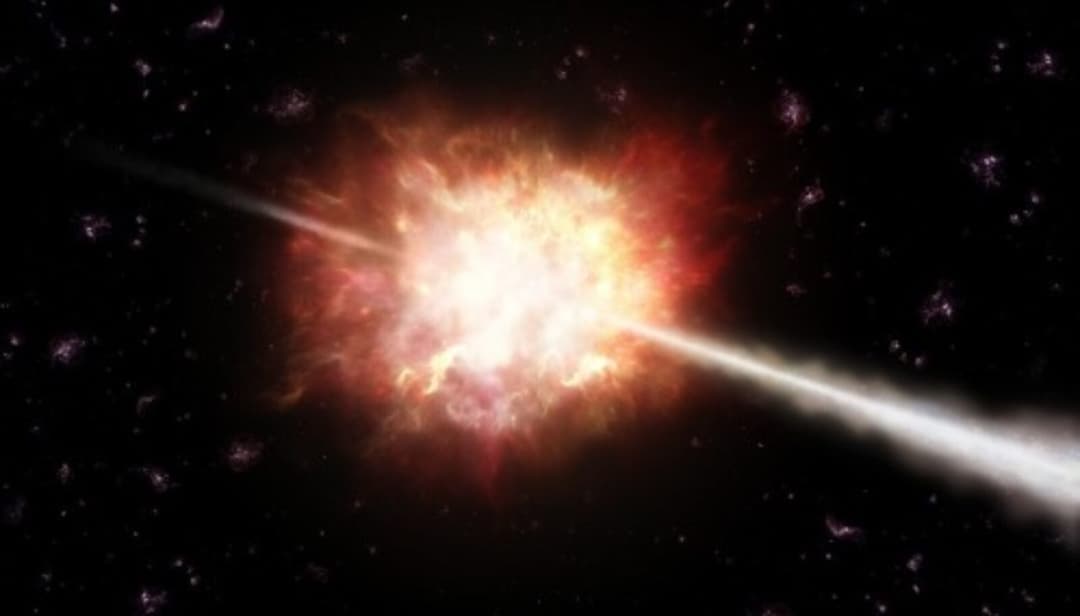The Highest-Energy Light Ever Recorded
by Adam Hadhazy
Ever-improving telescope technologies enable astrophysicists to peel back nature's layers, solving stubborn mysteries

The Author
The terms "science" and "technology" are often paired, and for good reason. For either to advance, you ultimately can't have one without the other. Astrophysics is an example of this inextricability par excellence. Take the case of gamma-ray bursts. The most powerful explosions in the universe, they come to us here on Earth as mere flashes of the highest-energy form of light, gamma rays. But to reach us from across billions of light years with such relative oomph, the events underlying these bursts somehow must unleash more energy in a few seconds than our Sun will pump out over its 10-or-so eons of radiance. Potent stuff, indeed.
For decades, the sources of these GRBs, as they're called for short, have perplexed astronomers—all the more so because the bursts occur over two distinct lengths, simply designated as short and long. Space telescopes, which can catch high-energy gamma rays that cannot penetrate Earth's atmosphere, have vastly expanded our knowledge about GRBs. But it took a key collaboration with two ground telescopes, sensitive to the most powerful gamma rays that do manage to punch through to the Earth's surface, to solidify at last the mechanism behind long GRBs.
One array, called the High Energy Stereoscopic System (H.E.S.S.), started up in the early 2000s, featuring a special 28-meter gamma-ray telescope as its centerpiece in Namibia. The second set of instruments, called the Major Atmospheric Gamma Imaging Cherenkov (MAGIC) telescopes, has operated in La Palma in the Canary Islands for a decade. Tipped off by the space-based telescopes just seconds after they captured the start of a GRB, these telescopes swung into action and soaked up rare, valuable photons of powerful light streaming from a cataclysm half a universe way. The observations of two GRBs—one by H.E.S.S. in July 2018, the other by MAGIC in January 2019—marked the first-ever ground-based detections of these cosmic blasts. Astonishingly, MAGIC caught photons with a trillion times the energy of those emitted by our Sun—the most powerful on record. Altogether, the data demonstrates that GRBs occur when massive stars go supernova and collapse into black holes. Material is hurled out by this explosion at tremendous, near-light speed, slamming into other material spewed out by the star, generating a shock wave and, in the process, gamma rays with exquisitely high energy. This full illustration of the anatomy of a GRB will surely not be the last astrophysical fruit borne of science and technology's union.
- Record-setting strong gamma rays reveal physics of colossal explosions
For the first time, researchers have captured very-high-energy gamma rays from a cataclysmic cosmic explosion called, appropriately enough, a gamma-ray burst (GRBs). Kavli Institute for the Physics and Mathematics of the Universe (Kavli IPMU) scientists were involved in the effort, which all but settles the mystery of how freshly formed black holes power long-lasting GRBs.
- A doppelganger dozen: Distant galaxy's visage repeats due to gravitational lensing
A new study has examined the Sunburst Arc, an extraordinary example of a distant galaxy that appears at least 12 times in the sky as stretched-out arcs around a closer-by galaxy cluster. That cluster's powerful gravity acts like a lens for the light from the distant galaxy, magnifying, warping, and duplicating the galaxy's appearance. Researchers from the Kavli Institute for Cosmological Physics (KICP) at the University of Chicago and the Kavli Institute for Astrophysics and Space Research at the Massachusetts Institute of Technology (MKI) are study coauthors.

- Galaxies undergoing stellar manufacturing slowdowns
A study, led by a member of the Kavli Institute for Cosmology, Cambridge (KICC), shows that as galaxies slow their starmaking, it's not only the amount of star-forming gas fuel that has gotten depleted—the galaxies also form stars at a slower rate with this leftover gas. In a novel analysis, the study made this assessment on a huge batch of local galaxies, 62,000 in all, demonstrating how to obtain this information without having to resort to long, deep, expensive observations.
- Sputtering supermassive black hole lets new stars form
It's a Kavli twofer. Researchers from the Kavli Institute for Astrophysics and Space Research at the Massachusetts Institute of Technology (MKI) and the Kavli Institute for Particle Astrophysics and Cosmology (KIPAC) at Stanford University have discovered why the Phoenix galaxy cluster sports a collection of young, blue stars, while most clusters' core regions are full of old, red stars. The supermassive black hole in the core of the cluster's central galaxy is going through a poorly understood, less-energetic phase, allowing gas to cool and form new stars.
- Seeing supernovae from the past
A story in Symmetry magazine explores how Mark Vagins, an experimental physicist at Kavli IPMU, had the idea to add gadolinium to the ultrapure water inside Japan's Super-K neutrino detector. Gadolinium uniquely soaks up neutrons released by water's interactions with a type of antineutrino, produced in prodigious amounts when stars explode. The gadolinium-doped detector should now be able to detect antineutrinos, via the neutron signal, from distant, ancient supernovae, allowing researchers to study these explosions in unprecedented detail.